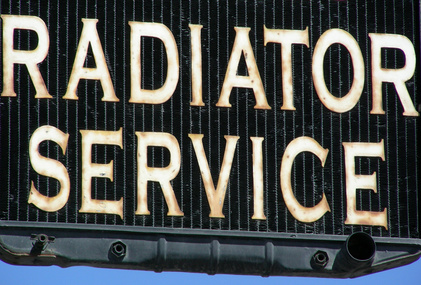
Most automotive engines are water-cooled, or more precisely, water-and-chemical-treatment-cooled. Your car, for instance, unless it's an old VW, uses a solution of 50 percent plain water and 50 percent chemical antifreeze/coolant. The liquid circulates via a water pump through the engine block to the radiator, where it cools before returning to the engine block. When antifreeze puddles on the ground under a vehicle, our first impulse is to check the radiator, although the source of the leak could be faulty hoses or the water pump itself. Don't ignore a coolant leak; doing may lead to engine overheating and possible failure.
Open the hood and locate the source of the coolant leak by first checking the black rubber radiator hoses. Locate the hoses that attach to the top and bottom of the radiator. Check the hoses for cracks or other damage. Tighten the hose clamps at each end of the hose with a Phillips screwdriver if the leak appears to be coming from the end of the hose.
Drain the remaining coolant from the radiator before you attempt repairs. Do this by placing a clean drain pan under the radiator drain valve. Loosen the drain valve with a pair of pliers. Tighten the drain valve when the coolant has finished draining. Remove the drain pan from under the vehicle.
Replace a leaking hose by loosening the hose clamps on each end of the hose. Slide the clamps away from the end of the hose. Slide the hose off the radiator fittings and the engine block. Work a stubborn hose off with a back-and-forth twisting motion. Replace a hose in reverse order and tighten the hose clamps.
Remove your radiator for replacement or repair if it is the leak culprit. Do this by removing the radiator hoses as in Step 3. Remove the retaining bolts from the plastic fan shroud on the radiator by loosening them with a socket and ratchet. Carefully work the shroud around the fan blades and pull it straight up from the engine bay. Loosen and remove the radiator retaining bolts on the side mounting flanges of the radiator. Pull the radiator straight up and out of the engine bay.
Have the radiator repaired by a reputable radiator shop or purchase a replacement radiator from your dealer or local auto parts store. Replace the radiator and shroud in the reverse order of Step 4.
Check for coolant leaks at the bottom of the water pump housing, which is mounted to the front of the engine block behind the fan. Replace a leaking water pump before it fails. Do this by first removing the fan shroud as in Step 4. Loosen the fan retaining bolts from the water pump shaft with a socket and ratchet. Lift the fan straight up from the engine bay. Remove the coolant hoses from the water pump as in Step 3. Loosen and remove the water pump retaining bolts with a socket and ratchet.
Pull the water pump straight back from the front of the engine block and out of the engine bay. Clean the mounting surface with a gasket scraper. Mount a new water pump using a new gasket and tighten the retaining bolts. Replace all hoses and other parts removed by following the reverse order of the above steps.
Remove the radiator cap and place a large funnel in the inlet. Pour the coolant from the drain pan into the radiator. Remove the funnel and replace the cap. Start the vehicle and let it run until it reaches operating temperature. Check for leaks and tighten any bolts or clamps as needed. Close the hood.